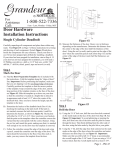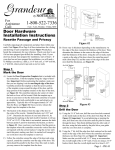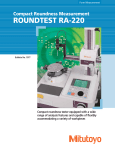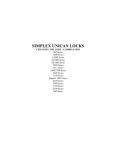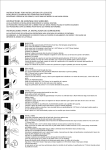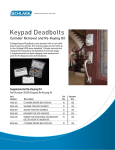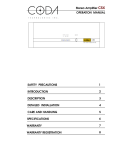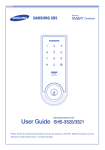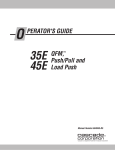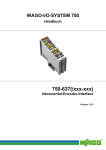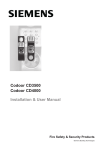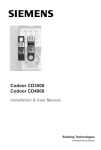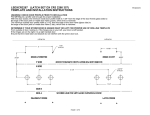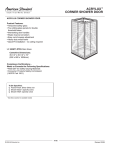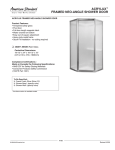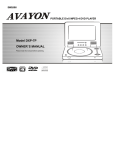Download Nostalgic Warehouse 733007 Instructions / Assembly
Transcript
4- For Assistance Call: 1-800-522-7336 8 am - 5 pm, Monday - Friday, MST Door Hardware Installation Instructions Single Cylinder Deadbolt NOTE: Deadbolts fit doors 1-3/4” to 2-1/4” thick. For thicker doors, please call customer service. Carefully unpackage all the components and place them within easy reach. Find Figure #1 on page 4 of these instructions for a listing and drawing of each component. Detach Figure #1 and place beside the components for easy refernce. If your door is already prepped (pre-drilled), start at Step 4. If your door has not been prepped for installation, you will need a #2 Phillips screwdriver, a drill, a 2-1/8” hole saw, a 1” drill bit (spade or forstner style), a 7/8” drill bit, a 1/8” drill bit, a razor knife, a chisel and a pencil, tape and an awl (or nail). B) Determine the backset of the deadbolt latch (Part #1) by checking the marking on the deadbolt latch itself. If the latch is not marked, measure the latch between points A and B to determine the backset, as shown in Figure #2. The backset will either be 2-3/8” or 2-3/4”. Once you know your backset, find the point on the template where the centerline crosses the vertical line that corresponds with the correct backset. Using the awl (or nail) mark this point, making sure that it is marked well enough to see on the door once the template is removed. C) Follow the centerline around the edge of the door and using a pencil, extend the centerline onto the edge of the door. The mark should be horizontal to the floor. Once this mark is made, you may remove the template from the door. D) Measure the thickness of the door. Doors vary in thickness depending on the manufacturer. Determine the distance from the center to the edge of the door (half the thickness of the door). Using the awl (or nail), mark a point on the edge of the door where the centerline pencil mark (from Step 1C) and the center of the edge of the door meet (half the thickness), see Figure #3. Figure #3 &ORv"ACKSET v v #ROSS"ORE (OLEv $IAMETER Step 1 Door Preparation For Deadbolt -ARKFROM 3TEP" A) Locate the Door Preparation Template which is included with these instructions. Fold the template along the “edgeof-door” line. Important: Before positioning the template, make sure that you are aligning it on the non-hinged edge of the door. Carefully position the template so that the narrow portion of the template wraps around the edge of the door, and the large portion of the template remains on the face of the door, see Figure #2. Slide the template up or down on your door so that the centerline is located at a height that is both comfortable to use and attractive in appearance. Typically, this will be approximately 36”-38” from the floor. Once you have chosen the height, tape the template to the door. &ACEOF$OOR 4EMP LA TE %DGE OF $OOR #ENTERLINE Figure #2 " %DGE"ORE (OLEv $IAMETER -ARKFROM 3TEP$ #ENTERLINE -INIMUM vTOCENTER LINEOFDOOR KNOBCROSS BOREHOLE v v &ORv"ACKSET -ARKFROM 3TEP# &ACEPLATE -ORTISE !REA $OOR4HICKNESS Step 2 Drill the Door A) Using the 2-1/8″ hole saw, drill the cross bore hole centered on the mark made on the face of the door from Step 1B. See Figure #3. Important: To avoid splintering or marring the door, drill from one side of the door until the pilot bit comes through the door. Then drill from the other side of the door, using the hole made by the pilot bit as your guide until the cross bore hole is complete. B) Using the 1″ bit, drill the edge bore hole centered on the mark made on the edge of the door where the centerline and center thickness met from Step 1D, see Figure #3. Important: Make sure that you drill a full 3-1/2″ deep to accommodate the overall length of the 2-3/8″ latch. If you are using a 2-3/4″ backset latch, then the overall depth must be at least 3-3/4″. ! Page 1 - PK133 Step 3 Step 5 Mortise for the Faceplate Install the “Outside” Half of the Deadbolt A) Using Figure #1 for reference, find the faceplate (Part #2). On the edge of the door, center the faceplate over the newly drilled edge bore hole, so that the D-shaped hole in the faceplate is centered over the 1″ edge bore hole. Align the faceplate so that the edges are parallel to the edges of the door and roughly centered side-to-side. Mark around the faceplate with a pencil and remove from door. A) Using Figure #1 for reference, gather together the cylinder assembly (Part #4), spin ring (Part #5A), the outside escutcheon (Part #5B), the deadbolt adaptor plate (Part #7) and two 1-1/4″ machine screws (Part #8). B) Using the chisel, score the outline of the faceplate. Next, chisel away the material within the outline to a depth of 1/8″. When you are done, you should be able to insert the latch (Part #1) into the edge bore hole, place the faceplate over the latch tongue (Part #1A), and have the faceplate be flush with the edge of the door. B) Place the spin ring over the cylinder driver bar (Part #4A) end of the cylinder, making sure that the narrower edge of the spin ring is closest to the key hole end of the cylinder. Insert the cylinder through the spin ring and escutcheon to make the outside assembly complete, see Figure #5. C) Again, using the faceplate as a template and the awl as a marking tool, mark for the two screw holes that will hold the faceplate on the door. Remove the faceplate from the door to avoid marring the finish. Then, drill the two screw holes using a 7/64″ drill bit. Make sure the holes are drilled at least 1″ deep. Having too small or too shallow a hole can cause the screws to shear off. C) From the outside of the door, insert the cylinder driver bar (Part #4b) through the “+” in the latch housing, making sure that the driver bar is oriented vertically with the latch bolt extending from the edge of the door. Installing Your Lock Step 4 Install the Latch A) Insert a screwdriver into the deadbolt latch housing (Part #1) and extend the deadbolt (Part #1A). Insert the deadbolt latch into the edge bore hole, making sure that the “+” is oriented towards the lower edge or bottom side of the deadbolt latch, see Figure #4. $EADBOLT,ATCH 0ART %XTENDED $EADBOLT 0ART! hv/RIENTEDONTHE LOWEREDGE D) Make sure that the cross bore hole will be completely covered by the outside escutcheon and that the Nostalgic Warehouse logo is oriented correctly. E) On the inside of the door, place the adaptor plate so that the beveled screw holes face away from the door and line up with the cylinder posts. Screw on the two 1-1/4″ machine screws to hold the outside assembly in place, see Figure #6. Do not tighten yet. $EADBOLT &ACEPLATE 0ART v,ATCH3TRIKE 7OOD3CREWS 0ART %DGE"ORE (OLE Figure #5 Figure #6 Figure #4 B) Add the deadbolt faceplate (part #2) over the deadbolt latch and make sure that it can sit flush in the mortised out area. Note: Some doors come prepared with rounded corners in the mortised-out area. If your door is prepared like this, simply use a chisel to square off the corners so that the faceplate lies flush with the edge of the door. C) Install the 3/4” latch & strike wood screws (Part #3) to hold the deadbolt latch and deadbolt faceplate in place. F) Align the outside escutcheon and cylinder with the door edge and snug the two 1-1/4″ machine screws down. Do not overtighten. G) Using the key, unlock and re-lock the latch to make sure that the action is smooth. If the screws have been over tightened, the latch may bind. Once the action is acceptable, move on to Step 6. Page 2 - PK133 Step 6 $UST"OX 0ART $OOR&RAME 2EINFORCER 0ART Adding the Inside Thumbturn Assembly A) Using Figure #1 for reference, gather together the thumbturn assembly (Part #8), and the two 5/8″ thumbturn machine screws (Part #9). B) Install the thumbturn assembly such that the driver bar coming through the latch housing is inserted into the slot on the back of the thumbturn. C) Align the holes on the thumbturn assembly with the two small holes on the adaptor plate, see Figure #7. )NSIDEOF $OOR $EADBOLT !DAPTOR0LATE 0ART !TTACHED 4HUMBTURN !SSEMBLY 4HUMBTURN!SSEMBLY 0ART v -ACHINE3CREWS 0ART Figure #7 $EADBOLT 0ART! D) Install the two 5/8″ thumbturn machine screws, making sure that the plate is positioned correctly before tightening the screws. Do not over-tighten the screws. E) Turn the thumbturn and the key separately to make sure that the action is smooth. If the screws have been over-tightened, the latch may bind. Once the action is acceptable, move on to Step 7. $OOR 3TOP 4RIM 3TRIKE0LATE 0ART Figure #8 v7OOD 3CREWS 0ART v,ATCH 3TRIKE7OOD3CREW0ART D) Using the strike plate (Part #13), mark the area to be mortised out for the dust box (Part #10), door frame reinforcer (Part #11), and strike plate. Use a chisel to mortise this area and make sure that once assembled, the strike plate sits flush to the door jamb. E) Place the door frame reinforcer over the dust box. Using the door frame reinforcer as a guide, find the holes closest to the outside of the house and drill two 7/64″ x 3″ deep holes for the reinforcer screws (Part #12). F) Install the reinforcer screws. Again, check to make sure the deadbolt and reinforcer line up and that the deabolt can be locked. G) Drill two holes for the strike plate and install the strike plate using the latch and strike wood screws (Part #3). Step 7 Installing the Door Reinforcer and Strike Note: If door jamb is already drilled, go to Step 7E below. A) With the deadbolt in the unlocked position, close the door. From the inside of the house, turn the thumbturn and identify where the bolt is contacting the door jamb. Lightly mark this with a pencil on the door jamb. Measuring in from the door stop trim, identify the center mark where the bolt hole needs to be drilled. Hint: If you cannot see the bolt clearly, or cannot mark the jamb with a pencil because the door is closed, you can cover the end of the bolt with a light amount of lipstick or similarly visible material. When you turn the thumbturn, the lipstick will mark the door jamb. Congratulations! You have completed the installation of your new Nostalgic Warehouse single-cylinder deadbolt. B) Using a 7/8″ drill bit, drill two holes centered 5/16″ above and below the center mark. These holes will overlap. Make sure each one is at least 1-1/8″ deep. C) Clean out the hole (if needed) and insert the black dust box (Part #10). Close the door carefully, making sure not to crush the dust box. Make sure that the deadbolt and dust box line up. If not, carefully enlarge the hole as needed. Page 3 - PK133 Part # 1 1A 2 3 4 4A 5A 5B 6 7 8 9 10 11 12 13 Part Description Latch Housing Latch Bolt Latch Faceplate Latch & Strike Wood Screws (5) Cylinder Body Driver Bar Spin Ring Outside Escutcheon Deadbolt Adapter Plate 1-1/4” Machine Screws (2) Thumbturn Assembly 5/8” Thumbturn Machine Screws (2) Dust Box Door Frame Reinforcer 3” Reinforcer Wood Screws (2) Strike Plate 9 8 7 6 5B 5A 4 4A 1 2 3 3 13 11 Page 4 - PK133 12 1 Latch 2 Latch Faceplate 3 Latch & Strike Mounting Screws (5) 4 Cylinder Body 4A Driver Bar 5A Spin Ring 5B Outside Escutcheon 6 Deadbolt Adapter 7 Mounting Screws (2) 8 Thumbturn Assembly 9 Thumbturn Mounting Screws (2) 10 Dust Box 11 Door Frame Reinforcer 12 3" Reinforcer Screws (1) 13 Strike Plate Figure #1 - Single Cylinder Deadbolt Exploded Parts Drawing 10






